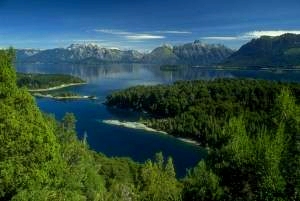 The
2006 Pan-American Advanced Studies Institute (PASI) on Nano
and Biotechnology will take place in San Carlos de Bariloche,
Argentina, from November 13 to 22. The event will convene
scientists in the field to promote interactions and develop
cooperative programs between diverse groups in the American
continent. It will be aimed at the young investigator and
it will include tutorials, specialized lectures, hands-on
laboratory modules and poster sessions for the participating
students (half from the US and half from Latin America). In
addition, debate sessions will be organized to discuss critical
science and technology issues related to the theme addressed
in the tutorials and invited talks presented each day. Emphasis
will be placed on the development and delivery of well-coordinated
tutorials. The
2006 Pan-American Advanced Studies Institute (PASI) on Nano
and Biotechnology will take place in San Carlos de Bariloche,
Argentina, from November 13 to 22. The event will convene
scientists in the field to promote interactions and develop
cooperative programs between diverse groups in the American
continent. It will be aimed at the young investigator and
it will include tutorials, specialized lectures, hands-on
laboratory modules and poster sessions for the participating
students (half from the US and half from Latin America). In
addition, debate sessions will be organized to discuss critical
science and technology issues related to the theme addressed
in the tutorials and invited talks presented each day. Emphasis
will be placed on the development and delivery of well-coordinated
tutorials.
The PASI will
address several topics including Nanomanufacturing, Single
Molecule Electronics/Spectroscopy, Mechanics of Biosystems,
MEMS/NEMS, Computational Nanomechanics and Multiscale design
of advanced materials. For more detail information see the
event program.
Bathed by the clear waters of Lake Nahuel Huapi, Bariloche
is located on the West of the Province of Río Negro,
1,640 km from Buenos Aires City. Founded in 1902, San Carlos
de Bariloche owes its name to Carlos Wiederhold, who set
the first grocery in the area, and to the distortion of
the term Vuriloche ("different people from behind or
from the other side"), used to name the natives from
the valleys located to the west of the Andes mountain range,
before the arrival of the mapuche people. Since then, Bariloche
has turned into one of the main tourist destinations in
Argentina. The facilities designed by man, as well as the
beauty offered by the natural environment, mingle in perfect
harmony to satisfy the visitor. Mount Catedral, one of the
most important ski resorts in Argentina, is visited more
and more by enthusiasts of snow sports every winter season.
The summers are synonym with adventure in Bariloche. The
rough watercourses are ideal for the practice of rafting.
The mountain paths are open for hiking, riding mountain
bikes and horses across the thick forests, and the high
peaks are a challenge for climbers.
Horacio D. Espinosa
Director
|